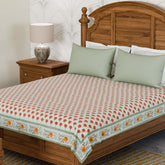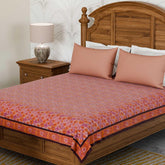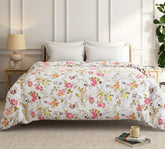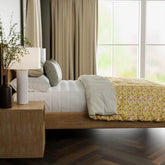Bed Sheet vs Bed Cover – Which One Should You Choose?

Have you ever realised that we spend almost one-third of our lives sleeping? And let’s be honest—good sleep depends a lot on comfort. One of the easiest ways to add comfort (and style) to your bedroom is by choosing the right bed linens.
But every time we shop for them, there’s one question that pops up: What’s the real difference between a bed sheet and a bed cover? And more importantly, which one do you actually need?
While both are used to cover the bed, they serve different purposes.
In this blog, we’ll break down the bed sheet vs bed cover comparison to help you understand their uses, features, and how to make the right choice for your bedroom.
Quick Summary:
-
Bed sheets are the basic layer you sleep on every night. They're usually soft, light, and made from breathable fabrics like cotton, making them comfortable against the skin.
-
Bed covers, on the other hand, are thicker and made from heavier materials. They sit on top of your bed sheet, protecting it from dust and giving your bed a more polished, stylish look.
Also Read: Cotton vs Cotton Blend: Which Fabric Should You Choose?
What is a Bed Sheet?

A bed sheet is the first layer you spread over your mattress. It sits right under your quilt, duvet, or blanket and gives you a soft, comfortable surface to sleep on.
Beyond comfort, a bed sheet also plays a key role in protecting your mattress from dust, sweat, and everyday wear and tear.
If you’ve ever wondered about the difference between a bed sheet and a bed cover, just remember that the bed sheet is the layer you lie directly on, making it essential for both comfort and hygiene.
Want to make your bed look extra special? Check out our embroidery bed sheets online. They’re designed to look great and feel amazing.
Materials and Types
Since bed sheets come in direct contact with your skin, the fabric plays a huge role in your comfort. Here are some common materials used for bed sheets:
Materials:
-
Cotton: Soft, breathable, and perfect for Indian weather — no wonder it’s the most popular choice.
-
Linen: Naturally airy and great for hot climates, though it tends to wrinkle easily.
-
Silk: Smooth, luxurious, and gentle on the skin, but it requires more delicate care.
-
Blends: Fabrics like cotton-polyester or bamboo blends are easy to care for, resist wrinkles, and are budget-friendly.
Popular Types of Bed Sheets:
There are two main types of bed sheets to know about:
-
Fitted Bed Sheets: These have elastic edges that hug the mattress and stay in place, making them ideal for restless sleepers.
-
Flat Bed Sheets: A simple rectangular sheet that you can tuck neatly under the mattress for a smooth finish.
Also Read: Comforter vs Blanket: Which One Is Right for You?
What is a Bed Cover?

A bed cover is the topmost cover you place on your bed during the day. It’s usually made from durable materials like thick cotton or wool, which makes it sturdy and long-lasting.
While a bed sheet gives you comfort, a bed cover focuses on protection and style.
It completely covers your bed sheet, blanket, and even pillows (in some cases), keeping them safe from dust, spills, and stains.
Plus, it instantly adds a neat, elegant look to your bedroom setup even when the bed isn’t in use.
Materials and Types
Bed covers come in a variety of materials and styles, allowing you to choose based on your needs. Here are the common materials used for making bed covers:
Materials:
-
Cotton: Soft, breathable, and easy to maintain—great for everyday use.
-
Polyester: Durable and wrinkle-resistant, often used in blends for easier care.
-
Silk: Luxurious with a smooth feel, perfect for a rich, sophisticated look.
-
Wool: Thick and warm, ideal for colder months or AC rooms.
-
Blended Fabrics: A mix of cotton, polyester, or other fibres to balance comfort and durability.
Popular Types of Bed Covers:
-
Duvet Covers: These are protective covers for your duvet or comforter. They often come with buttons or zippers, making them easy to remove and wash.
-
Quilts: Lightly padded and stitched in patterns, quilts add both warmth and style. They're great for mild winters or air-conditioned rooms.
-
Bedspreads: These are larger, full-length covers designed to drape over the entire bed, often reaching the floor. They keep your bed looking neat and give your room a clean, hotel-like finish.
-
Comforters: Fluffy and insulating, comforters are ideal for colder climates or cosy winter nights. They’re typically used with duvet covers to make cleaning easier.
Difference Between Bed Cover and Bed Sheet
|
Feature |
Bed Sheet |
Bed Cover |
|
Purpose/Function |
Provides sleeping comfort, hygiene, and protects the mattress. |
Mainly decorative; protects the entire bedding from dust and dirt. |
|
Placement |
Spread directly over the mattress. |
Placed on top of the bed sheet, blanket, or duvet. |
|
Texture |
Soft, thin, and lightweight for comfort. |
May be soft, but usually thicker, quilted, or sturdy. |
|
Types |
Flat sheets or fitted sheets. |
Includes quilts, coverlets, duvet covers, and comforters. |
|
Usage |
Stays on the bed during sleep and throughout the day. |
Often removed before sleeping and put back for a neat daytime look. |
|
Care |
Requires frequent washing since it touches the skin; dries quickly. |
Washed occasionally; heavier fabrics may take more time and effort to clean. |
Also Read: 15 Cheap Living Room Decor Ideas That Actually Work
How to Choose Between a Bed Sheet and Bed Cover

When deciding between a bed sheet vs a bed cover, it all comes down to your comfort, climate, and style preferences.
-
For daily comfort: Go for soft, breathable cotton bed sheets—they’re perfect for everyday use, especially in Indian weather.
-
For decor and protection: Add a bed cover to keep your bed looking neat and shield your bedding from dust and stains.
-
Best of both worlds: Use both—a comfy bed sheet for sleeping and a stylish bed cover for a polished daytime look.
At the end of the day, your bedding should reflect both your functional needs and your personal style. Mixing and matching allows you to get the most out of your bedroom setup.
How to Use Bed Sheets and Bed Covers Together
Want to get the most out of your bedding setup? Here's the ideal way to layer a bed sheet with a bed cover:
-
Start with a bed sheet: Whether you’re using a fitted or flat sheet, spread it over the mattress. If it’s a flat one, make sure to tuck it tightly under the mattress for a neat, secure setup.
-
Add warmth with a blanket or quilt: This layer keeps you cosy at night. Use something light like a dohar for summer or a quilt for colder weather.
-
Finish with a bed cover: Lay a stylish bed cover on top. It protects the bedding underneath and gives your room a clean, put-together look. You can either tuck it in for a neat finish or let the sides hang for a relaxed, cosy vibe.
Also Read: Ceramic vs Porcelain Plates – Which One Should You Choose?
Conclusion
Now that you understand the difference between a bed sheet and a bed cover, choosing the right one becomes easy and smart. Think of the bed sheet as your comfort layer: soft, breathable, and gentle on your skin. It’s the part you sleep on, so it should feel just right.
On the other hand, the bed cover is your style layer. It’s the finishing touch that not only protects your bedding but also elevates the look of your room.
And when you combine both, you get the best of comfort and style.
At Eyaas, our bed sheets and bed covers are hand-crafted from natural fibres like 100% cotton. They're soft, breathable, eco-friendly, and thoughtfully designed to make your home look and feel beautiful — inside and out.
FAQs
1. What is the main difference between a bed sheet and a bed cover?
A bed sheet is the layer you sleep on—it covers the mattress and provides comfort. A bed cover is placed on top of the bed sheet or blanket for protection and decoration.
2. Can I use a bed cover without a bed sheet?
Technically, yes—but it’s not ideal. Bed covers are not always as soft or skin-friendly as bed sheets. It’s better to use both for comfort and cleanliness.
3. Do bed covers go over blankets or comforters?
Yes, bed covers are usually placed over blankets, quilts, or comforters during the day to protect them from dust and give the bed a neat look.
4. How often should I wash my bed sheet and bed cover?
Bed sheets should be washed at least once a week since they are in direct contact with your skin. Bed covers can be washed less frequently, depending on usage—once every 2–3 weeks is ideal.
5. Which material is best for bed sheets in Indian weather?
Cotton is the best choice for the Indian weather. It’s soft, breathable, and good at absorbing moisture, making it perfect for year-round comfort.
6. Are bed covers only for decoration?
No! While they do make your bed look stylish, they also serve a practical purpose by protecting your bedding from dust, spills, and wear.









 https://eyaas.in/
https://eyaas.in/





Leave a comment
Please note, comments need to be approved before they are published.